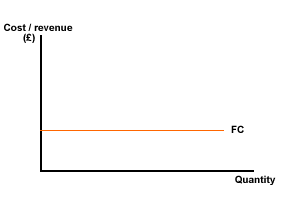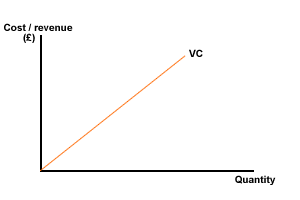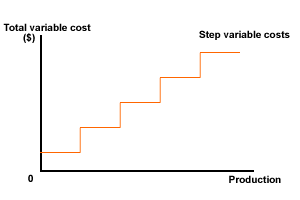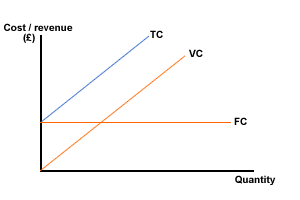Types of costs
To be able to control costs, it is necessary to understand more about them and from where they arise. In this section we examine the nature and classification of costs.
Costs are usually classified according to their relationship with the level of output of the firm. The following costs are therefore defined in relation to how they change in value as the level of output varies.
Fixed costs

Fixed costs
Fixed costs are costs that do not vary with the level of output in the short term.
Examples of fixed costs
- Rent
- Office salaries
- Advertising
- Insurance
- Depreciation
Fixed costs can be represented on a graph and this would appear as follows:

Figure 1 Fixed costs
A common mistake made by candidates in examinations is to state that fixed costs will always remain constant. This is not the case, as these costs are fixed with respect to short-term changes in the level of output only. In the long-term, a firm may rent a second factory or take out more insurance cover, so fixed costs are likely to change.
Variable costs

Variable costs
A variable cost varies in direct proportion with the level of output. Varying directly means that the total variable cost will be totally dependent on the level of output. If output doubles, then the variable cost would double. If halved, the variable costs would halve. If output were zero, then no variable costs would be incurred.
Common examples of variable costs are as follows:
Example of variable costs
- Direct labour
- Raw materials and components
- Packaging costs
- Royalties
Variable costs can be represented on a graph and this would appear as follows:

Figure 2 Variable costs
Semi-variable costs

Semi-variable costs
A semi-variable cost is an expense, which includes a mixture of fixed and variable components. These costs vary (change) with output, but not in direct proportion The fixed cost element is the part of the cost that must be paid irrespective of the level of activity. On the other hand the variable component of the cost is payable proportionate to the level of activity. These costs are sometimes called mixed costs. In some cases, costs may be fixed for a set level of production, becoming variable after that level is exceeded.
In reality, nearly all costs cannot easily be classified into either fixed or variable. Most costs will fall somewhere between the two classifications. In this case, we classify these as semi-variable costs.
For example, although the wages of the production staff may appear to be variable costs, in reality, they will vary with the level of output, but not in a direct manner. The direct relationship is unlikely to hold over a long period of time. Similarly, many costs will have a fixed element, but also a variable element (for example, most bills for gas and electricity will consist of a standing charge, which is fixed and a variable element, which will depend on the usage). Telephone bills often contain a fixed line rental, but call charges vary with the number made, the distance of the call and the time elapsed. A telephone bill will aggregate these different charges.
What would the graph of a semi-variable cost look like?
As there is a link between the cost and the level of output, we would expect the semi-variable cost curve to be upward sloping. However, there is no accurate 'textbook' appearance for this curve. It will normally slope upwards in a non-linear manner, although this may be stepped or curved.


Examiners find the concept of semi-variable costs particularly difficult to integrate into examination questions - particularly break-even analysis - so semi-variable costs are often ignored, even though they are normally the most common cost.
Total costs

Total costs
Total costs are the sum of fixed costs, semi-variable costs and variable costs for any particular level of output. If the output level is zero, then total costs would consist only of fixed costs.
In nearly all cases, total costs will be the addition of total fixed costs and total variable costs (where total variable cost is the variable cost per unit multiplied by the level of output).
Total variable costs = variable cost per unit x output level
Total costs = fixed costs + variable costs
Total costs can be represented on a graph and this would appear as follows:

Figure 3 Total, fixed and variable costs
Direct costs

Direct costs
A direct cost is similar to a variable cost in that it compares the cost with the level of output. However, a direct cost is any cost, which is directly related to the output level of a particular product or department. Direct cost is more appropriate for a firm that makes more than one type of product.
For example, assume a firm is producing both chairs and tables. The chairs produced use a certain type of wood, but the tables use another type of wood. Then both types of wood would be direct costs, because they are directly related to the level of output of a particular product, not to the level of output in general.
Indirect costs

Indirect costs
An indirect cost is any cost, which cannot be linked with the output of any particular product or department. These costs are also known as indirect overheads or administrative costs. They are related to the level of output of the firm, but not in a direct manner and not for any one product.
For example, the cost of powering machinery will be related to the level of output, but not to a particular product.
Generally, the terms indirect and direct costs are more likely to be used when the firm produces a range of products. In break-even analysis, the firm will only be producing a certain product type. This means that the terms fixed and variable costs are more likely to be used.

Costs - task
Now, a task for you that will check if you understand the new terms you have just met.
Imagine that you have decided to start a business, Student Enterprises Ltd, offering a home delivery service for DVD's. You are next door to a large rental firm who are prepared to supply you, so you will not have to buy stock yet. What would you have to spend money on to set the business up and then operate it?
Make a list of all the costs that you can identify. Examine the list you have made, and then classify the costs between fixed and variable costs. When you have done this, click Costs for Student Enterprises Ltd.
A final question; what type of cost is labour?
The answer here starts with a phrase that is very common within business and management. The answer starts with - 'It all depends'. It all depends on how the labour is paid. Make a list of as many payment schemes (different ways people are paid) as you can think of, then click on Remuneration. Look up the term in the glossary as well.
This means that for much of the time labour is a fixed cost, fixed for the period of the employment contract. Relatively few people are paid solely on the basis of what they produce. Most employees have elements of both fixed and variable payments in their remuneration.
You will often be asked to give examples of fixed and variable costs. When answering this type of question, it may be best NOT to use labour as an example.
